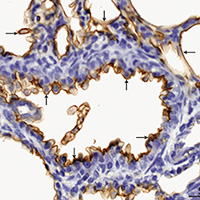 Smart Citations
Smart CitationsSee how this article has been cited at scite.ai
scite shows how a scientific paper has been cited by providing the context of the citation, a classification describing whether it supports, mentions, or contrasts the cited claim, and a label indicating in which section the citation was made.
Presence of N-acetylgalactosamine/galactose residues on bronchioloalveolar cells during rat postnatal development
In mammals, the alveolarization process develops predominantly after birth. Airway cells display a complex assemblage of glycans on their surface. These glycans, particularly terminal glycan extensions, are important effective carriers of information that change during the differentiation process. Nevertheless, few systematic data are reported about the cell surface sugar residue content during post-natal lung development. In the present work, we aimed to identify and semi-quantify N-acetylgalactosamine (GalNAc)/galactose (Gal) residues on the bronchioloalveolar cell surface in rat lung sections from 1-, 4-, 8- day old and adult animals and link these data with the lung glycocalyx composition. Horseradish peroxidase-conjugated lectin from Glycine max (soybean agglutinin, SBA) was used, and light microscopy methodologies were performed. SBA labelling intensity was studied before and after sialidase pre-treatment, at one-, four- and eight-day-old animals and adult animals. For semi-quantitative evaluation of SBA binding intensity, two investigators performed the analysis independently, blinded to the type of experiment. Reactivity of the lectin was assessed in bronchiolar and respiratory portion/alveolar epithelial cell surfaces. We evidenced a stronger positive reaction when lung sections were pre-treated with neuraminidase before incubation with the lectin in one- and four-day-old animals and adult animals. These results were not so manifest in eight-day-old animals. This binding pattern, generally points towards the presence of terminal but mainly sub-terminal GalNAc/Gal residues probably capped by sialic acids on the rat bronchiolar/respiratory tract epithelial cells. As this glycan extension is common in O- and N-glycans, our results suggest that these glycan classes can be present in bronchioloalveolar cells immediately after birth and exist during the postnatal period. The results observed in eight-day-old rat lung sections may be due to the dramatic lung morphologic changes and the possible underlying biological mechanisms that occur during this age-moment.
How to Cite
PAGEPress has chosen to apply the Creative Commons Attribution NonCommercial 4.0 International License (CC BY-NC 4.0) to all manuscripts to be published.








